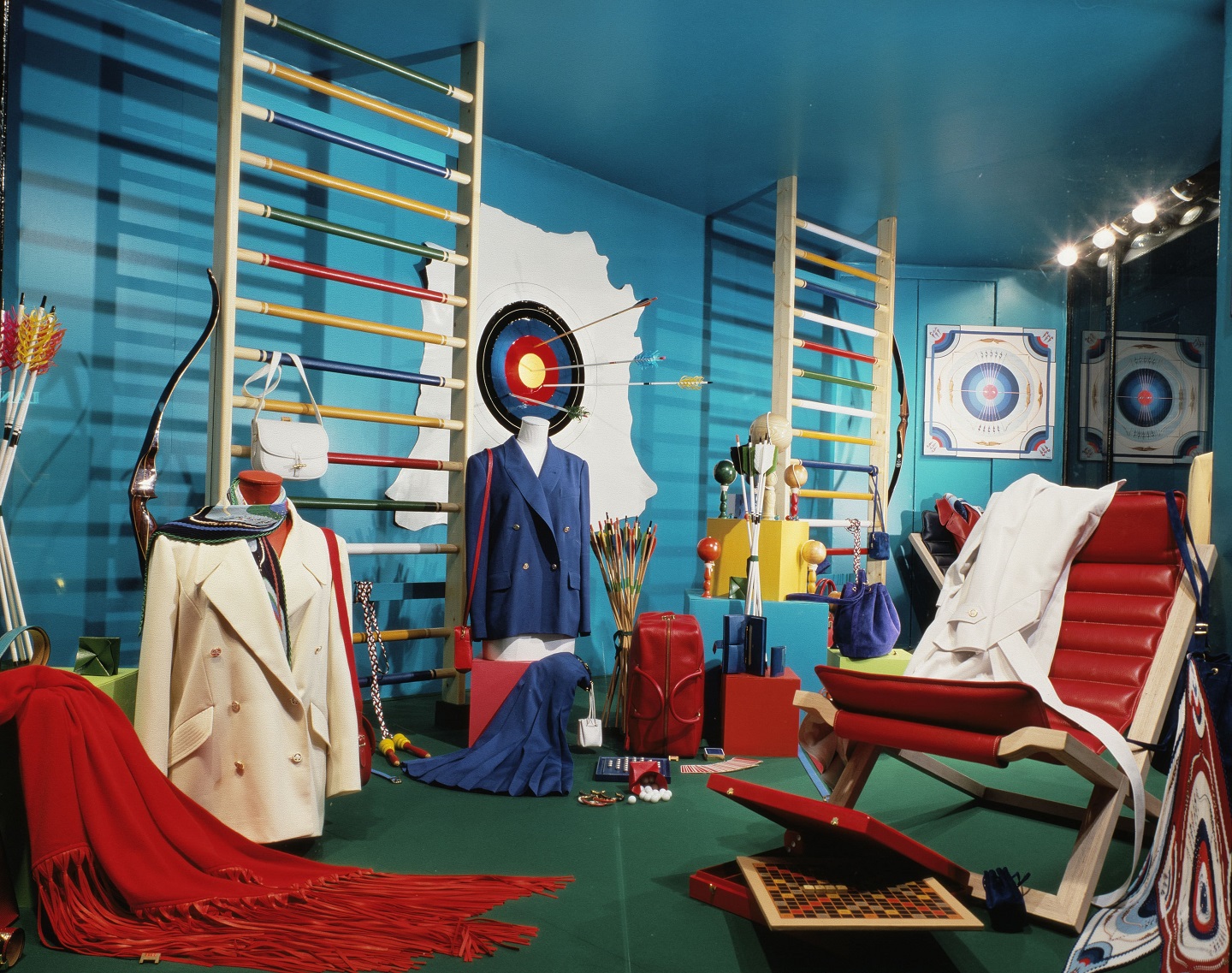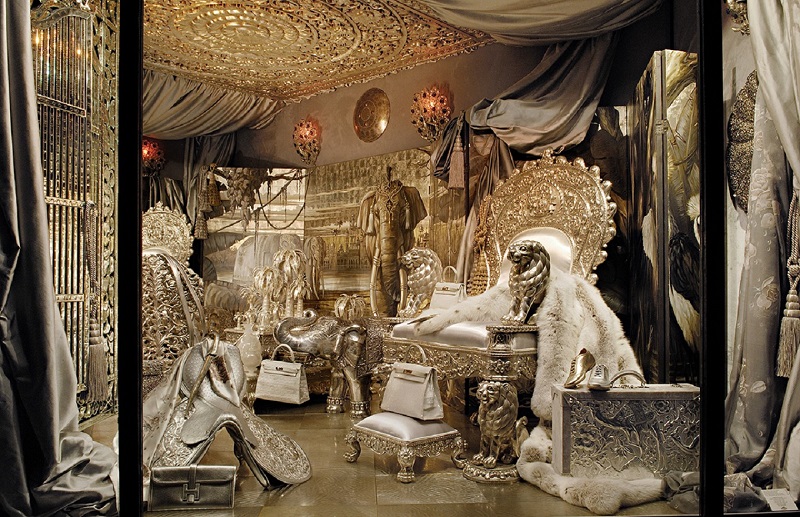
(Photo: Hermès)
When Hermès decided to honour its most prolific artist, Leïla Menchari, the outcome was an extravagant showcase of her work — a weighty luminous tome featuring over 100 of her window displays as well as an exhibition in Paris’ prestigious Grand Palais highlighting eight of her iconic designs.
Produced in collaboration with well-known scenographer Nathalie Crinière, the book features Menchari’s translation of her designs into lifelike theatre sets, which were then populated with Hermès’ luxurious artefacts, each one telling a unique story of its own.
Both the book and exhibition salute her vivid imagination and indisputable bohemian style of merging fantasy with reality, together with exotic crafts, rich textiles and robust stonework.
A Tunisian salon with its intricate bas-relief, carved mythical creatures and opulent Egyptian tombs were among the dream-like displays brought to life. This magical rhapsody became the signature of Hermès flagship windows during her five-decade tenure working along the Faubourg Saint-Honoré.
The world that Menchari grew up in was filled with rich scents and sounds, sea and sand, abundant travel in the Tunis countryside and a pastime filled with large family gatherings.
Born into a progressive Tunisian family of landowners, she had a loving Francophile professional father who was determined to allow his daughters to blossom and not be curbed by the limitations of being a woman in an Arab world. Her mother, a great-granddaughter of the Sultan of Touggourt, was an active advocate of women’s rights and the rejection of the veil, which condemned women to a life hidden away.
Sent away to study at an early age to a Catholic boarding school, Menchari discovered that she had no real interest in studies except for French and drawing. A dreamer, she constantly longed for contact with the outside world. Her love for nature and curiosity about cultures and rituals stimulated her imaginative mind and fed her interest in the arts. Her experience living in Hammamet — a seaside oasis that attracted artists and intellectuals from around the world — during school holidays crystallised her desire to pursue her passion.

Encouraged by her parents, Menchari, then 16, was sent to the Beaux Arts in Tunis and thereafter in Paris to complete her education and training. Upon graduation, while living as a struggling artist in Paris, she met fellow Tunisian designer Azzedine Alaïa, who then introduced her to the world of high fashion and couturier Guy Laroche. Smitten by her rare beauty and mysterious persona, Alaïa immediately made her his muse and engaged her as an in-house model.
Such was her allure. Menchari was aware that the novelty of a model from the Orient who was the great-great-granddaughter of a sultan would have glamourised the shows. But Menchari was not fulfilled by the modelling world and had no desire to pursue it as a profession. Consequently, she returned to drawing and developed an interest in designing sets for theatre, which were filled with fantasy and wonder.
A chance introduction in 1961 to Hermès’ head of window display, Annie Beaumel, changed her life forever. “Draw me your dreams,” said Beaumel on seeing her portfolio of work. From then on, Menchari was given the job to illustrate her storybook of thoughts and reveries for Beaumel. She became her dutiful assistant and illustrator, and in return, Beaumel involved Menchari in every aspect of the process, guiding her through the processes of the fashion house — from understanding colour mixing and materials to the detailed production in Hermès workshops: leather, silk, silver, jewellery and fashion.
As her skills improved, Menchari was asked to design other objects for Hermès. Her illustrations were rendered across silk, clay, beads and leather bringing a new dimension to Hermès’ beautiful scarves, jewellery and luggage.
In 1978, after over 50 years with the fashion house, Beaumel handed the reins of her department to Menchari — her protégée and design collaborator. Through Beaumel, Menchari discovered the richness of this artistic discipline and learnt to embrace the splendour of Paris and the life it had to offer.

As the new head of the decoration team, and under the fresh leadership of Jean-Louis Dumas, Menchari was given complete freedom to intensify her creativity. She drew inspiration from her childhood years growing up in Tunisia and travels around the Maghreb — a region filled with beautiful countryside. From her reminiscences of joyous festivities filled with sumptuous feasts, storytelling and dance, she found memorable inspiration at every turn.
But nothing inspired her more than her travels to Hammamet, the seaside paradise on the eastern shore of Tunisia. Hammamet promised the splendour of unspoiled beaches, exotic Mediterranean gardens and its unique iridescent light. And it was there that she met American Jean Henson with his Garden of Paradise, which would become her foremost source of inspiration in all her work.
In her later years, Menchari travelled the world with Dumas to study other cultures and communities, discovering new artisans and relics along the way. Africa, India, Japan and more, she looked for beauty universally.
She was driven to creating displays that realistically portrayed the exquisiteness of each country — its colours, its seasons and its flora and fauna. Every detail was confronted. Each window had to lure the viewer into its world and it was important for Menchari to conceive a window that struck a fine balance between the rational and irrational, with the presence of Hermès’ luxurious objects.
Leïla Menchari, The Queen of Enchantment is an extraordinary story of Menchari’s life — the artist who found her creative calling in the most prestigious fashion house in Paris. It is a story about her devotion to her country and family, her commitment to artistic excellence and her romantic relationships with the people she met and places she visited.
The book equally honours the House of Hermès, the artists and artisans Menchari discovered and the family she made in her adoptive country. Lavish photographs of her dazzling displays over several years covering various countries, themes and seasons are interspersed throughout the book.
In 2013, the “woman behind the window” retired but her imprints live on. As she profoundly concluded in her book, “Beauty must be handed down like an inheritance. And to bear witness to beauty is to engage in an absolute quest.” And so it has.
Leïla Menchari, The Queen of Enchantment, narrated by Michèle Gazier for Menchari, is available from Hermès.


